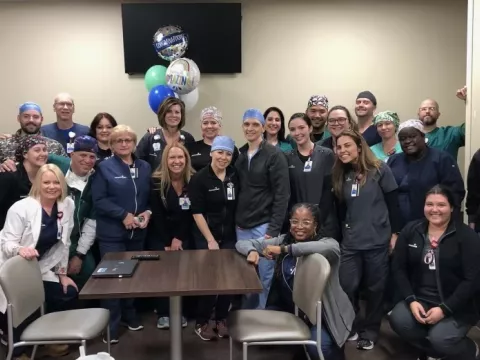- AdventHealth
This Physician's View opinion piece is written by Susan Kelly, MD. pediatric hematologist and oncologist and medical director of bone marrow transplant at the AdventHealth for Children
Acute lymphoblastic leukemia (ALL) is the most common cancer occurring in children in the United States, and the predominant type of ALL begins in B cells (B-ALL). Standard chemotherapy cures more than 80% of these cases. However, for the remaining 15-20% of patients, chemotherapy does not work at all or only for a short time, resulting in limited treatment options and low survival. The disease can also relapse after a bone marrow transplant (BMT), and refractory or relapsed ALL is one of the leading causes of cancer-related deaths in children.
Chimeric antigen receptor (CAR) T-cell therapy is an exciting form of cancer immunotherapy that uses genetically altered, patient-derived T cells to find and destroy cancer cells. In 2017, the U.S. Food & Drug Administration (FDA) approved a form of CAR T-cell therapy called tisagenlecleucel (brand name Kymriah) for the treatment of patients up to 25 years of age with B-cell precursor ALL that is refractory or in second or later relapse. AdventHealth for Children is home to the first and only FACT-accredited Pediatric Cellular Therapy Program in Central Florida, and we treated our first patient with this cell-based gene therapy in February 2021. We have since treated two additional patients with another currently in process, offering families hope where there was once none.
CAR T-cell Therapy Outcomes

Between 80% and 90% of all patients treated with CAR T-cell therapy will experience an initial response, and approximately 50% will achieve a sustained remission of at least five years. Since this therapy is the only chance many of these children have, even 50% is a huge win.
At AdventHealth for Children, our first CAR T-cell therapy patient was Karthikeya (Karthi) Anga. He was first diagnosed with B-ALL at age 3, and he underwent an allogeneic hematopoietic stem-cell transplant (allo-HSCT) at age 11 after two relapses. However, his cancer relapsed a third time about a year later. After careful consideration and close consultation with Karthi’s parents, we pursued CAR T-cell therapy. His treatment was administered as an outpatient, and he experienced limited side effects. Now, a year and a half later, he remains in remission. After missing so much school due to his cancer, Karthi is loving school, making new friends and thriving in 8th grade. His favorite subject is math, and he hopes to pursue studies in advanced robotics and engineering so that one day, he can research and develop new medical treatments for children. In addition, thanks to his improved health, Karthi and his family recently traveled back to their home country of India for the first time since moving to the United States.
The CAR T-cell Therapy Process
Tisagenlecleucel is an autologous anti-CD19 CAR, and with this treatment, a patient’s own T cells are transduced to express an anti-CD19 CAR. Once infused back into the patient, these new cells bind and kill the CD19+ leukemia cells. There are four steps to CAR T-cell therapy treatment:
- Cell collection and cryopreservation — We use leukapheresis to collect and separate the patient’s T cells, and then cryopreserve them.
- Manufacturing — The patient’s cryopreserved cells are then shipped to an FDA-approved manufacturing facility where they are genetically reprogrammed into CAR T cells to fight the patient’s B-ALL.
- Infusion — The patient receives lymphodepleting chemotherapy to prepare the body for the CAR T cells, and then the new cells are infused back into the body in a single setting, either outpatient or inpatient, depending on the patient’s needs.
- Monitoring — Once the infusion is complete, the treating physician monitors the patient for side effects closely for a month followed by routine, long-term monitoring.
Identifying Good Candidates for CAR T-cell Therapy
While it isn’t a first-line treatment, CAR T-cell therapy adds to our cancer-fighting arsenal, providing a new treatment option for children with disease that persists despite traditional chemotherapy as well as for those who experience too many side effects from their chemotherapy. It can also serve as a bridge therapy to get patients into remission so that they can receive a BMT. Pediatric and young adult patients who meet the following criteria can be considered for CAR T-cell therapy:
- Disease refractory to frontline chemotherapy treatment (primary refractory)
- Relapsed disease and cannot achieve remission (chemorefractory)
- Second or subsequent disease relapse following complete remission or stem cell therapy
With CAR T-cell therapy, there are many factors to consider. Early referral of patients who may benefit or who may need a stem-cell transplant allows us to formulate the best, personalized treatment plans and prepare for whatever they may require.
Potential Side Effects
CAR T-cell therapy is easier on the organs than traditional cancer therapies, but it can cause acute toxicities, especially in the initial two to four weeks after treatment. That said, as our experience grows with this therapy, it has become safer and is generally well-tolerated. One of the side effects that has drawn the most attention and concern is cytokine release syndrome (CRS), an acute systemic inflammatory response. It results from a large number of white blood cells activating and releasing inflammatory cytokines, which in turn, activate even more white blood cells. Fortunately, we now have medications such as tocilizumab that can block CRS without hindering the effectiveness of the CAR T cells. Additional CAR T-cell therapy side effects include blood pressure fluctuations, confusion and sleepiness. Some patients may also require oxygen. In general, the more disease a patient has, the more likely they are to experience side effects after their CAR T-cell treatment.
Looking Ahead
As clinicians, we are continuing to hone the use of CAR T-cell therapy so that we can optimize its use and efficacy. Ongoing research is exploring the following questions:
- Who is the right patient and when is the best time to use CAR T-cells? Researchers are exploring how to maximize the treatment’s effectiveness and increase 5-year survival rates.
- Who needs more therapy? There are ongoing clinical trials to determine how long these cells need to persist in the body. In addition, a recent Phase I trial demonstrated that alloHSCT after Car T-cell therapy can mediate durable disease control in a significant number of children and young adults with relapsed or refractory B-ALL.
- Who else could benefit? Additional studies are examining the potential use of CAR T-cell therapy for other types of cancer, including acute myeloid leukemia (AML) as well as solid tumors.
This is an exciting time to work in the field of pediatric cellular therapy. New technologies and medical innovations like CAR T-cell therapy are opening doors to treatment that were once closed. We are curing patients previously incurable and with less toxicity. Most importantly, they are saving lives and offering new hope for patients like Karthi who may someday discover his own medical breakthrough or cure.
If you have a patient who could potentially benefit from CAR T-cell therapy or BMT, please contact us here.





